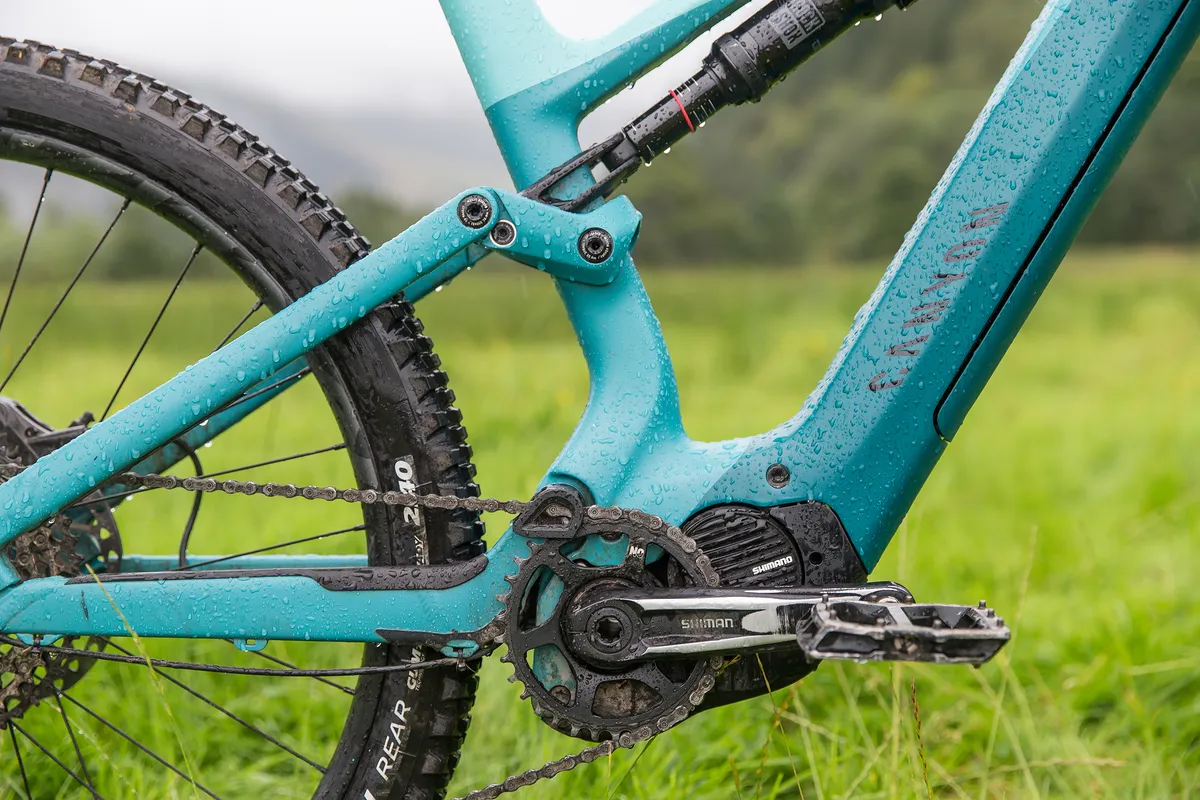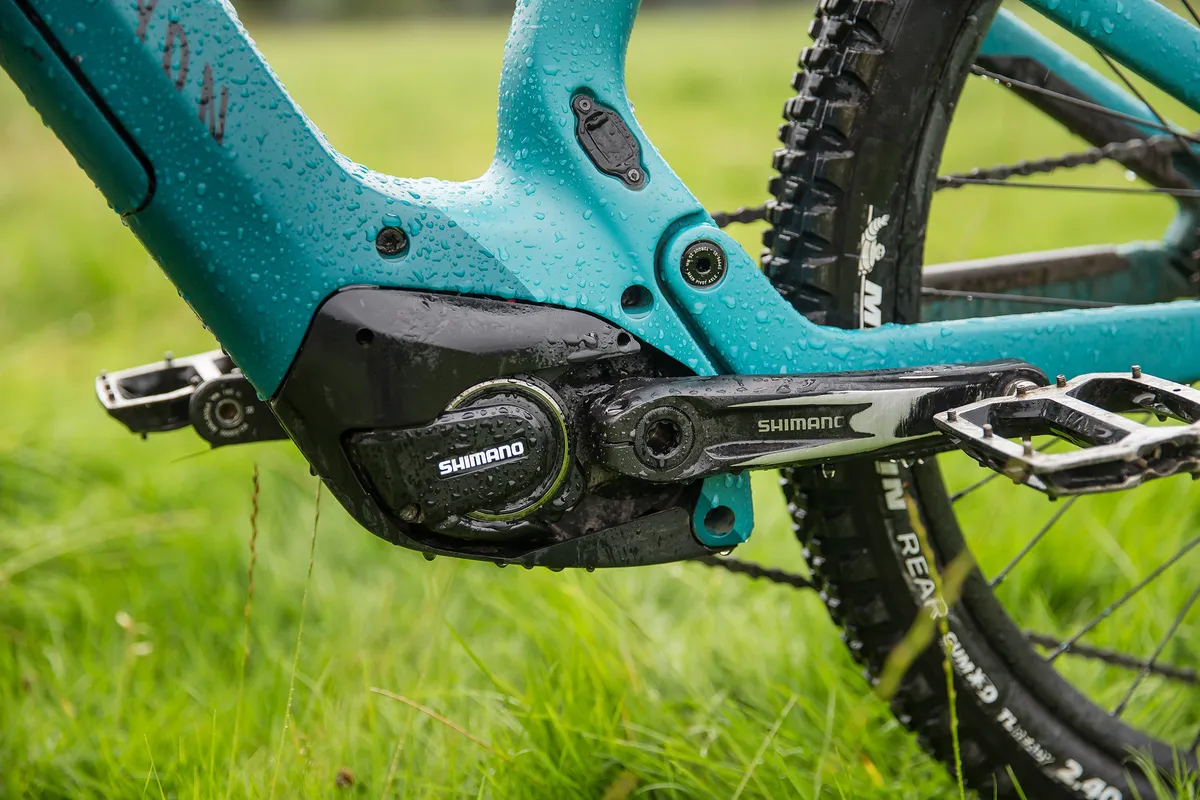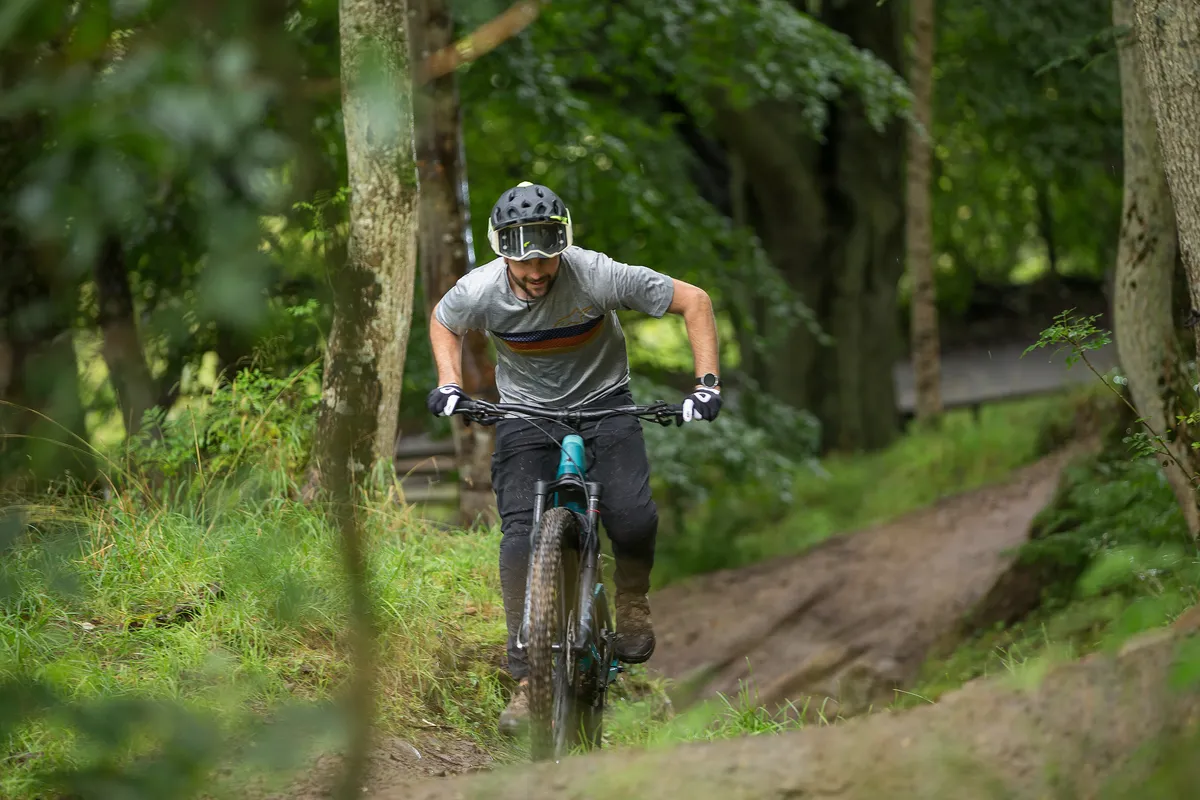Launched in March 2020, the latest iteration of Canyon’s Spectral:ON had a total redesign, including the integration of Shimano's 504Wh battery into the bike’s down tube and further refinements of the frame’s aesthetic.
I’ve already reviewed the top-spec CF 9.0 version and was impressed with the amount of fun I had riding the mullet-wheeled bike, but wanted to see how much of that was down to the spec and whether a cash-conscious buyer could enjoy the more-affordable (£4,299 / €4,479) CF 7.0 just as much.
Canyon Spectral:ON CF 7.0 frame and suspension details

Built with a carbon-fibre front end – that conceals the 504Wh battery – and an alloy rear end, there’s nothing to distinguish the cheaper 7.0 frame from the more expensive 9.0.
It’s got a waterproof USB-C port that can be used to charge GPS computers or power an 0n-board light and a single power button near the head tube, internally routed brake, gear and dropper cables and an integrated chain guide.
The seatpost foregoes a traditional clamp, instead there’s a discrete wedge on the front of the seat tube to keep the post in place.

It has 150mm of rear wheel travel controlled by Canyon’s impressively progressive suspension system with low anti-squat figures to help improve compliance. The lowest-spec 7.0 bike has a RockShox Deluxe Select shock with external rebound adjustment and two tokens fitted as standard.
There’s 12 x 148mm Boost rear axle spacing and a QUIXLE tool-less rear axle to attach the back wheel.
Canyon Spectral:ON CF 7.0 motor and battery details

The Spectral:ON CF 7.0 is fitted with Shimano’s E8000 Steps motor with a maximum 250W assistance output. It has Shimano’s 504Wh battery and E8000 pedal crank with 34-tooth chainring.
The E8000 motor is no longer Shimano’s newest and most powerful system after the Japanese brand launched its EP8 system earlier this year, with headline torque increases and larger battery capacities.
Canyon Spectral:ON CF 7.0 geometry
The size large CF 7.0 I tested has the same geometry as the more expensive model and is based around a mullet setup – where the rear wheel is 27.5in in diameter and the front 29in.
The crucial figures include a 66.5-degree head-tube angle, a 74.5-degree seat-tube angle, 435mm chainstays and a 465mm reach.
The large’s wheelbase is 1,221mm and has a 635mm stack height.
Arguably, the Spectral:ON’s geometry is ‘playful’ rather than progressive.
- Seat tube length: 480mm
- Seat angle: 74.5 degrees
- Head angle: 66.5 degrees
- Top tube (effective): 632mm
- Reach: 465mm
- Chainstay: 435mm
- Wheelbase: 1,221mm
- Stack: 635mm
- Head tube length: 125mm
- Sizes (* tested): S, M, L*, XL
Canyon Spectral:ON CF 7.0 specifications
Despite the CF 7.0 being the cheapest Spectral Canyon offers, it’s still fitted with a host of branded, high-performing parts.
Notably, it’s got a Shimano XT 12-speed rear mech and an SLX 10-51-tooth cassette and shifter. There are also four-piston Shimano MT520 brakes with 200mm disc rotors.

It’s got a Race Face AR30 29in front rim built onto a Shimano MT400 hub and a Race Face AR35 rear wheel laced to a Shimano MT510 hub.
Those wheels are wrapped in Maxxis rubber, with a Minion DHF 2.5 x 29in WT EXO TR front tyre and a Minion DHR II 2.6 x 29in EXO+ rear.

There’s a RockShox Lyrik Select fork with external rebound and low-speed compression adjustment that’s fitted with two tokens from the factory and a RockShox Deluxe Select rear shock with external rebound adjustment, also fitted with two tokens from the factory.
Canyon-branded parts make up most of the finishing kit including the electric mountain bike specific bars, stem and saddle. It’s got a Canyon Iridium Dropper seatpost and Canyon lock-on grips.

The CF 7.0 in a size large without pedals weighed 22.32kg, slightly heavier than Canyon’s claims.
Canyon Spectral:ON CF 7.0 ride impressions

I tested the Spectral:ON CF 9.0 on the hills outside Barcelona in Spain earlier this year, so I was keen to see how a different version of the same model would perform on my home trails in wetter and more varied conditions.
Canyon Spectral:ON CF 7.0 setup
Canyon’s rear suspension system was easy to set up, pressurising the air spring to give 25 per cent sag for my 73kg weight — which was around 165psi.

Canyon fitting two tokens from the factory was key to the set up’s simplicity.
The fork was a little trickier to get right. Although the Lyrik is fitted with a Charger damper, it was the more basic version and the low-speed compression functions more like a lock-out than a true compression adjuster, which made me hesitant to use it to control the fork’s damping.
After several rides and a few hairy bottom-outs, I ended up adding an additional token to the two already installed in the bike and increasing air pressure in the fork to 125psi. Although this seems pretty hard for my weight, I still got full travel regularly.

I inflated the front tyre to 26psi and the rear to 31psi, raising pressures to accommodate the heavier hits electric bikes generally take.
Elsewhere, it was just a case of dialling in brake lever angle, saddle angle and bar roll.
Of note, the cable between the motor’s left-hand remote mode switch and handlebar display unit had been pinched, which stopped the remote from working.

Without the remote the bike was still usable – the small button on the underside of the display could be used to change modes – until I replaced the cable with another one, which cured the problem.
Canyon Spectral:ON CF 7.0 climbing performance

The motor is always going to be an ebike’s most dominating element, and the Shimano E8000 didn’t disappoint. While it doesn’t have as much torque as Bosch’s Performance Line CX or the new EP8, it still provided plenty of punch to power to the top of the steepest climbs.
Admittedly, if I wanted to keep speed up or conserve battery life I did break into a considerable sweat, especially in Eco and Trail modes, but the assistance offered is predictable and easy to manage with changes in pedalling input pressure when the terrain is slippery or the gradient very steep.
It’s tricky to differentiate support levels between Trail and Boost modes on most climbs, and I was more than happy leaving the Steps system in Trail for 90 per cent of the time. Only when the climbs became incredibly steep or technical did the Boost mode help.

Leaving the system in Trail mode 100 per cent of the time depleted the 504Wh battery after 1,050m of climbing and roughly 27km distance in 17 to 18°C temperatures. When left entirely in Boost mode, I managed to do 850m of climbing before the battery ran totally flat.
The best compromise seemed to be using Eco mode wherever it was possible and reducing my average speed, only upping the assistance to Trail for the steepest sections of climbs. Employing that strategy, I could hit 1,245m of climbing before totally draining the battery.
Battery life will depend on a multitude of factors including rider weight, weather conditions and trail type so don't be surprised if you manage to get more or less range from the 504Wh battery compared to my experiences.
While the seat tube angle isn’t particularly steep, the stepped rear portion of Canyon’s ebike saddle, the SD:ON, helped to keep my weight further forward than a traditional one. It would be good to see brands like Canyon increasing seat tube angles to better centralise rider weight on climbs to improve comfort and control – a change that would be particularly beneficial on an ebike.
Generally speaking, though, the bike’s climbing position was comfortable, especially when seated. Out of the saddle, it felt a little cramped but the motor’s assistance compensated for this by providing on-demand power – something ‘acoustic’ bikes with less than ideal geometry can’t compensate for.

The plus-size rear Maxxis Minion DHR II tyre provided plenty of grip on the ascents, even at my preferred higher ebike pressures, and unless the terrain was boggy, it didn’t clog up with mud.
The 22.32kg weight didn’t appear to hold me back and unless I was hopping up and over roots and rocks, it actually helped me keep the bike under control.
Canyon Spectral:ON CF 7.0 descending performance

The Spectral:ON was impressively confident in the turns. Once it was leant over, it felt like it kept on gripping no matter how hard it was pushed. This meant cornering speeds were exhilarating and relatively easy to access.
I believe the lean angles and grip available were generated by the low-slung motor, down tube battery and mullet wheel setup making the bike more eager to lean.
Despite the geometry – particularly the reach and heat tube angles – not being the most extreme, the bike managed to handle most rough and technical terrain I could find with relative ease.
It was when the descents became more steep with lots of large steps that I felt like the bike was reaching its limit. This happened because the additional weight from the motor and battery caused the chassis to pitch forwards and began to overwhelm the head-tube angle, fairly short reach and fork damper.
A slacker head-tube angle would help to reduce this pivoting feeling and I can see no disadvantages to decreasing it to 63 or even 62 degrees on an ebike, where motor assistance plays the largest part on the climbs and flat terrain.
At high speed, the Spectral:ON felt more flicky and playful than totally planted, but the large and low weight of the motor helped to maintain a reasonably calm platform from which to shred.
Its rear suspension also helped keep things in check, proving to be exceptionally supple and active over smaller bumps while retaining that all-important end-stroke ramp up for the big hits. Canyon has worked hard to get its suspension dialled across its range of bikes – like the Neuron – and the Spectral:ON is no exception.
On occasion I did notice the simplistic RockShox Deluxe Select shock becoming overwhelmed by larger successive hits, something the more expensive CF 9.0 with Fox DPX2 Factory shock didn’t suffer from. Overall, though, it performed solidly, and the damper tune was well-suited to the frame’s kinematic.

Once I’d inflated the fork to 125psi and upped the token count to three it performed well, absorbing big hits while remaining supple enough for comfort.
The Lyrik chassis felt stiff enough for the speeds I could access on the Spectral, but it would be interesting to see whether a RockShox ZEB or Fox 38 would improve performance.
Shimano’s four-piston MT520 brakes impressed me and didn’t suffer from a wandering bite point like some other Shimano stoppers do. They managed to control the bike’s weight well and I was never left hanging on for dear life wanting to stop quicker.

Equally, the XT mech and SLX chain and cassette have been faultless and I’ve not dropped a single chain.
The biggest let down for me was the rear tyre’s EXO+ casing which ripped beyond repair on a rocky trail fairly early on during the testing period. I believe the ease at which the tyre ripped was exasperated by the bike’s weight and increase tyre wear associated with ebikes.

At the very least I think a Double Down or similar casing tyre should be specced on electric mountain bikes. The weight penalty is negligible on both the climbs and descents on an ebike, but the additional security and control given by a stiffer and stronger rear tyre would be a great improvement with no significant drawbacks.
I replaced the Maxxis with a Michelin Wild Enduro Rear Gum-X tyre and haven’t suffered a single puncture since.
Canyon Spectral:ON CF 7.0 bottom line

So, does the CF 7.0 equal the performance of the more expensive 9.0 model for a fraction of the £6,499 cost? In short, pretty much, yes.
The motor and battery are the same, as is the frame’s geometry. The 7.0’s brakes, drivetrain and wheels perform as well as the XTR and Reynolds parts on the more expensive bike. The tyres are also identical across the two models, so you’ll run into the same problems with premature punctures on the 9.0, too.
And although the CF 9.0’s Fox Factory suspension is better than the 7.0’s RockShox kit, the Lyrik and Deluxe don’t drastically prohibit fun or reduce performance.
For that reason, if you’ve got your heart set on a Spectral:ON, there’s very little incentive to buy the more expensive model over the cheaper CF 7.0.
Product
| Brand | Canyon |
| Price | €4497.00, £4299.00 |
| br_whatWeTested | Canyon Spectral:ON CF 7.0 |
| Weight | 22.32kg |
Features
| Fork | RockShox Lyrik Select |
| Stem | Canyon:ON ST0030 |
| Frame | Canyon Spectral:ON |
| Motor | Shimano Steps E8000 |
| Tyres | Maxxis Minion DHF 2.5x29in WT EXO TR (f), Maxxis Minion DHR II 2.6x29in WT EXO+ TR (r) |
| Brakes | Shimano MT520 |
| Cranks | Shimano E8000 |
| Saddle | Canyon SD:ON |
| Wheels | Race Face AR30 rim on Shimano MT400 hub (f), Race Face AR35 rim on Shimano MT510 hub (r) |
| Shifter | Shimano SLX M7100 |
| Cassette | Shimano SLX M7100 |
| Seatpost | Canyon Iridum Dropper |
| Grips/tape | Canyon Lock-On |
| Handlebar | Canyon:ON HB0056 |
| Rear shock | RockShox Deluxe Select |
| Bottom bracket | Shimano STEPS E8000 |
| Available sizes | Small, medium, large, extra-large |
| Rear derailleur | Shimano Deore XT M8100 |
